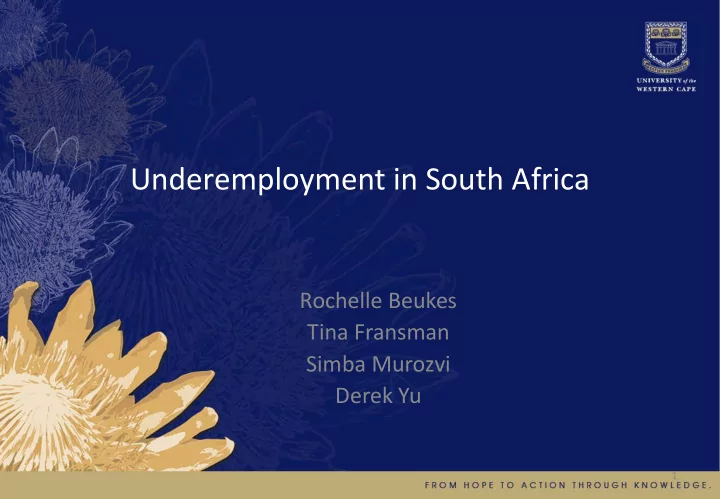

Underemployment in South Africa Rochelle Beukes Tina Fransman Simba Murozvi Derek Yu 1
Outline • Conceptual framework • Theoretical framework • Review of past empirical studies (very few…) • Data & Methodology • Empirical findings • Conclusion 2 2
Conceptual framework 3
Conceptual framework • Time-based underemployment (visible / quantitative) 1) Only worked fewer than 35 hours in the past week AND 2) Willing and available to work additional hours AND 3) Able to start the extra work within the next four weeks • Over-qualification / Skills related underemployment (invisible / qualitative) 1) First approach : Education years are one standard deviation above the mean education years associated in his/her relevant occupation category 2) Second approach (‘weak’ method…): Education level is above the required education level at the relevant occupation category, as defined by the South African Standard Classification of Occupations (SASCO). Example: Manufacturing industry (mean = 15 years, standard deviation = 1 year) If I work in this industry and my education year = 17 > (mean + 1 std dev), I am defined as under- employed… 4
Theoretical framework Ideal outcome… Under-employed 5
Theoretical framework W 1 = A job requiring Matric Ideal outcome for W 2 = A job requiring Matric + Certificate degree holder… W 3 = A job requiring Degree Full employment to someone with post-Matric Certificate Under-employment to Degree holder 6
Review of past empirical studies • Altman (2003): – Underemployed = informal + private hholds + agriculture – Underemployed as % of employed was 21% in 2001 • Altman (2009), Yu (2009) & Mathebula (2013): – Time-based underemployed – More likely to be female Blacks aged 15-24 years, residing in KwaZulu-Natal and Free State, without Matric, in unskilled occupations 7
Review of past empirical studies • Moleke (2005) – Primary survey on 2 600 university graduates – Skills-based underemployment – Underemployment likelihood higher for graduates coming from EMS, followed by Humanities and Arts. • Schoeman et al. (2010): – Underemployment from macro perspective – (Capital / Labour ratio) = f(Strikes, etc.) – Significant & positive econometric relationship 8
Data & Methodology • Data – 1995-1999 October Household Survey (OHS) – 2000-2007 Labour Force Survey (LFS) – 2008-2016 Quarterly Labour Force Survey (QLFS) • Methodology: Time-based – Drawback: (3) was not asked in OHS 1995-1999 9
Data & Methodology • Methodology: Over-qualification 1) First approach : Educ year > (mean + 1 s.d.) • Example : ‘Managers’ occupation: mean = 10 ; s.d. = 2 If I work in this occupation, and my education year = 13 > 12 , then I am classified as underemployed • Example : ‘Operators’ occupation: mean = 7 , s.d. = 1 If I work in this occupation, and my education year = 5 < 8 , then I am NOT classified as underemployed (rather FULLY employed) 2) Second approach : Educ level > Required educ level • Example: I work in the ‘clerks’ occupation that requires Matric, but I have Matric + Cert/Dip, so I am classified as underemployed • Could more seriously over-estimates under-employed as time goes by, as required educ level is NOT adjusted… 10
Data & Methodology 11
Data & Methodology 12
Data & Methodology 13
Empirical findings 14
Empirical findings 15
Empirical findings 16
Empirical findings 17
Conclusion – Summary of main findings: • The prevalence of underemployment was greater on individuals who were blacks, females, working in elementary occupations or private households, and the informal sector. • Economic growth was associated with lower time-based underemployment rate. – Possible further research in future: • Total labour income foregone due to underemployment • Econometric relationship between underemployment and the business cycle indicators • The likelihood of the underemployed being fully employed over time (this would require panel data) • Possible labour market policies to deal with underemployment 18
Recommend
More recommend